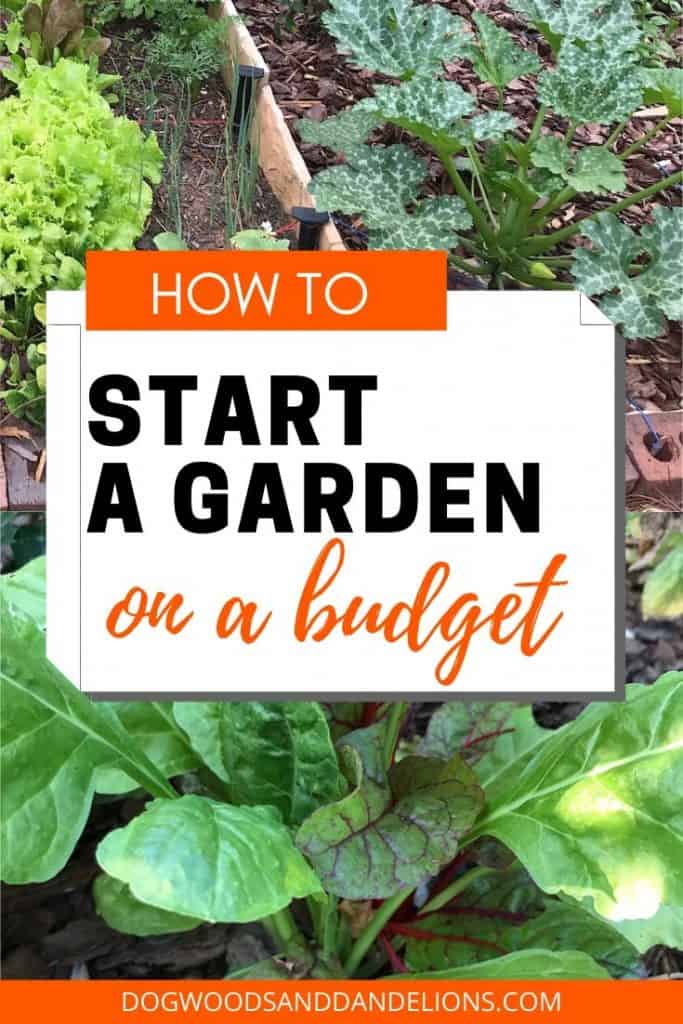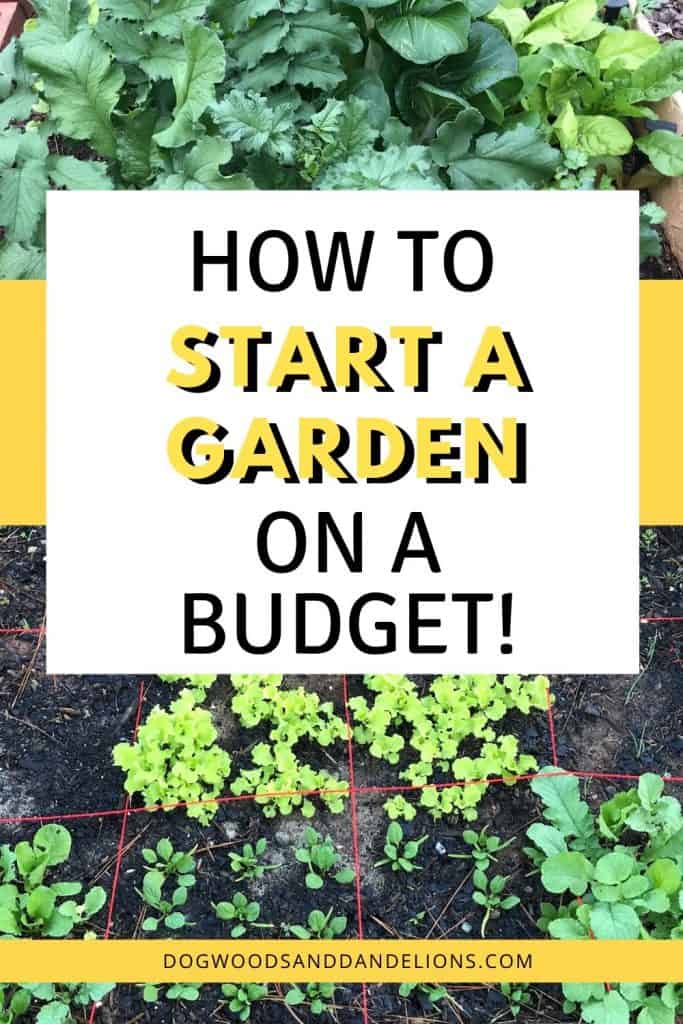How To Start A Garden On A Budget
Looking to save money when growing a garden? These ideas will help you start a garden on a budget and reduce your gardening start-up costs.
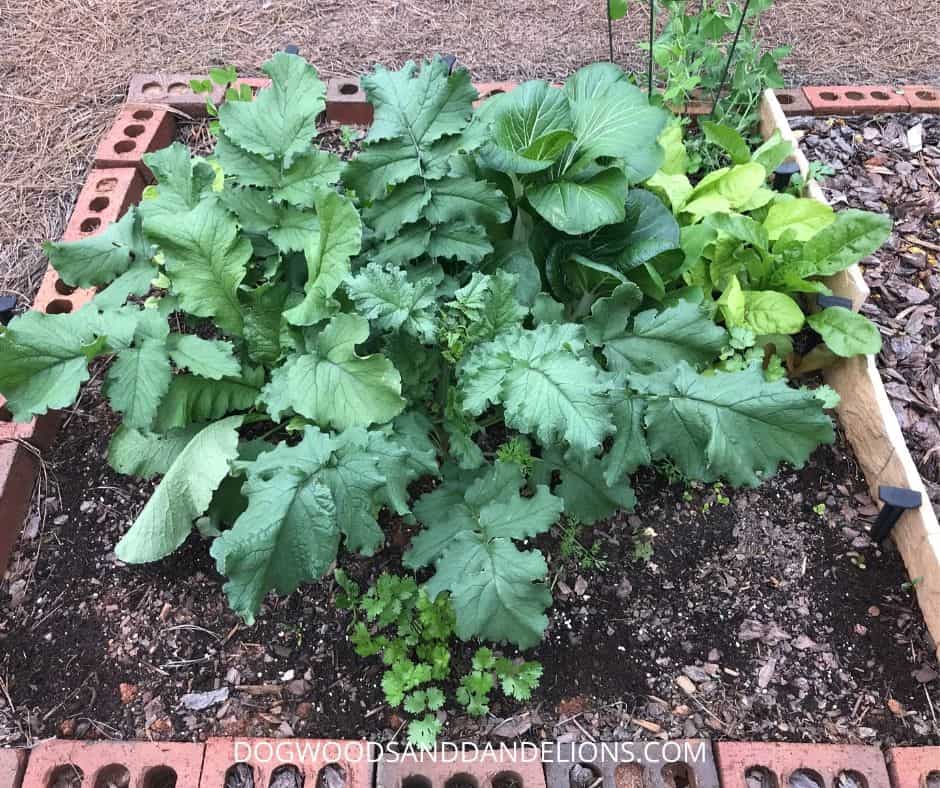
Affiliate Disclosure: Please note that some of the links in this article may be affiliate links and I may receive a small commission if you purchase something through a link. It will not change your cost. As an Amazon Associate, I earn from qualifying purchases. For more information, see my disclosures page.)
Start A Raised Bed Garden On A Budget
If you want to make a raised bed on a budget, the best way to build your raised bed is to try to find materials you can re-purpose. For the raised bed border, look for free items you can use.
If you can find large rocks, extra bricks from your house, or even large sticks from the woods, they can all be repurposed to designate the border of your garden bed. Cinder blocks can be used as well, though they are wide and take up extra space in your garden.
Usually, the soil to fill a raised bed is the most expensive part. To fill your raised bed, look for used potting soil from old containers.
Check with your neighbors to see if they have old containers that you could empty into your bed. (You can share some fresh produce with them later.) Add a bit of fertilizer or compost to your soil to help your plants along.
(And what better time to start your own compost pile so you’ll have FREE fertilizer for next year!)
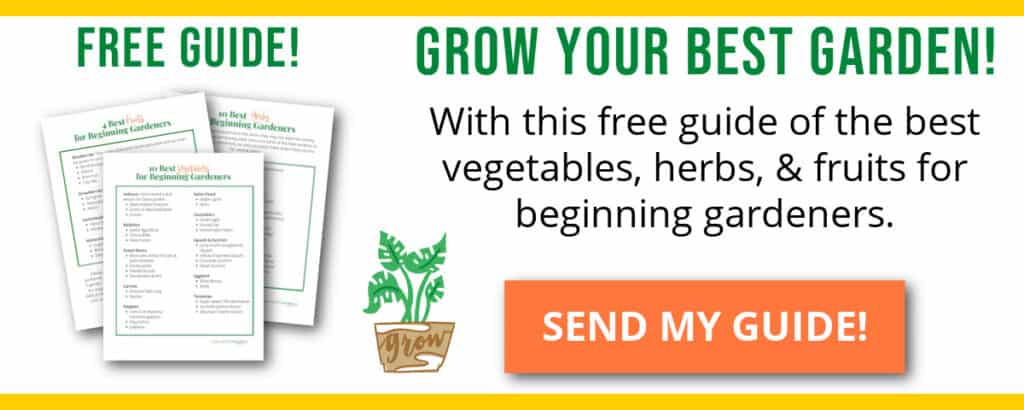
Saving Money On An In-The-Ground Garden
Grow A Garden in Black Plastic
One option for an in-the-ground garden is to put down black plastic. (I’ve got a whole tutorial on using black plastic in your garden.)
If possible put down the plastic and wait a month or so before planting. This will allow the weeds to die down and not compete for nutrients with your plants.
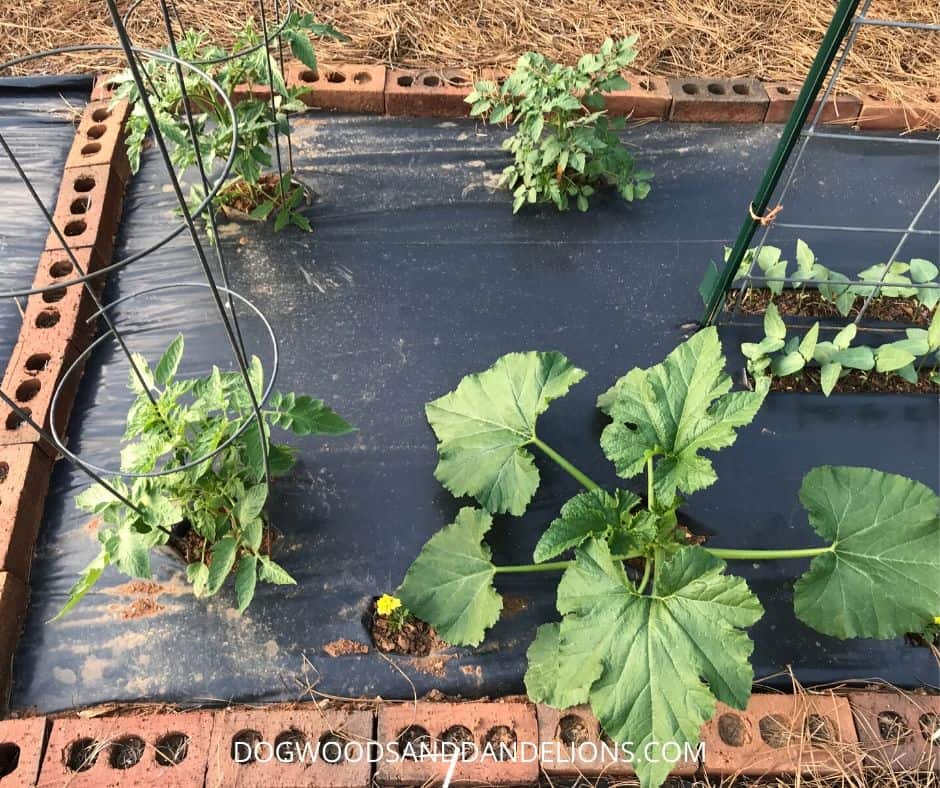
Using black plastic will reduce your watering needs and minimize the weeds that come up in your garden. You’ll save time by not having to weed your garden, and save money on your water bill.
The savings on your water bill will probably more than make up for the cost of the plastic.
A Traditional Row Garden
If you really want a row garden, see if you can borrow a tiller from your neighbor to till the soil. If not, you can rent them.
Keep in mind, if you are planting a traditional row garden you will have to till the soil each year. So if you are renting one, keep those costs in mind when you decide on what type of vegetable garden you want to grow.
While at first, growing a traditional garden can seem cheaper, that isn’t necessarily true. You waste money watering the entire garden, including walking paths.
You typically also spread fertilizer over the entire garden too.
You’ll spend more time weeding than in any other type of garden and an in-the-ground garden takes more room than container gardening or raised bed gardening.
In the long run, it may be cheaper to build raised beds or use black plastic as both of these methods will cut down on your maintenance time too.
Side note: I am not a huge fan of a traditional tilled garden. Every time you run the tiller, you are disturbing the ecosystem of your soil. However, I grew up with this type of garden and I realize that some still prefer it, so I’m sharing options here.
Start A Container Garden Inexpensively
If you want to start a container garden on a budget, look for old containers that you can re-purpose. Some ideas include food-safe buckets, unused planters, even old nursery pots that you purchased landscape plants in.
To prepare the containers, wash them thoroughly and allow them to dry. Drill drainage holes in the bottom if the container doesn’t already have any.
Fill with good quality potting soil and you are ready to start planting.
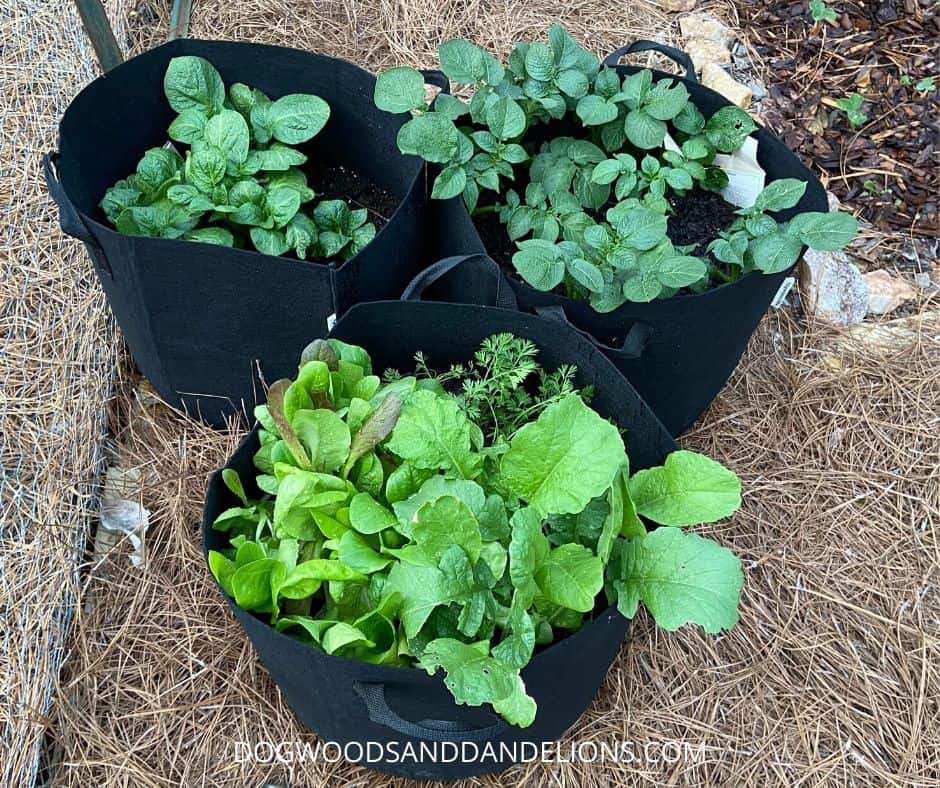
Another inexpensive alternative to containers is grow bags. Grow bags are fabric pots that you can plant food and flowers in.
They come in many different sizes and fold up flat for the winter. I absolutely LOVE grow bags. You can purchase small ones for individual plants or large ones to plant an entire herb garden in.
And recently I have even seen grow bags in a variety of bright colors to liven up your vegetable garden or patio.
Though I have a rather large raised bed garden, I still love to use containers and my preferred containers lately have been grow bags. (The picture above contains 3 of my current grow bags filled with potatoes, radishes, carrots, and lettuce.)
Grow Food Among Your Flowers
Another idea is to add a few vegetables to your flower beds. You would be surprised at what you can grow among the flowers.
A cherry tomato plant placed at the back of your border looks beautiful when the tomatoes ripen.
Rainbow Swiss chard looks pretty with its colorful stems and the plants can be eaten like lettuce as baby greens. Allowed to grow, they can be cooked similar to other greens like collards or used in soups and stews like spinach.
You can plant blueberries as landscape plants very easily. The bushes are beautiful in the spring when the flowers bloom.
They provide delicious purple berries in the summer. Then when fall rolls around, the foliage turns a gorgeous shade of burgundy.
You can tuck some lettuce just behind your annual flowers and strawberries make a great border for your flower bed. If you’ve got even a small flower bed, there is some kind of food you can grow among (or in place of) the flowers.
Getting Plants (and Maybe Seeds) On The Cheap
Another way to find inexpensive plants and possibly seeds, it to check with other gardeners in your area. A huge benefit to this is they will probably either sell them cheaply or some may even give them away.
A second benefit to getting plants and seeds from other gardeners in your area is that the varieties are probably some that grow well in your particular climate and gardening zone.
I personally almost always start too many tomatoes and peppers simply because sometimes a few fail to germinate. To ensure I have enough, I plant more than I need.
So I am happy to GIVE my extras away to anyone who wants them. Because when I’m out of room in my garden, I’m out of room.
The extras get thrown away if I can’t find someone to give them to which is a little bit sad. I much prefer them to go to a good home where they will bless someone else with food too.
And with many states banning the sale of seeds right now due to the current situation, I would happily share a few seeds with others too. I almost always have extras of some varieties.
After all, if this is your first garden, I hope you’ll START SMALL. So you really wouldn’t need too many seeds anyway!
Grow Crops That Produce A Lot Food for The Amount of Space
Another way to save money when gardening is to grow crops that provide a lot of food for little cost. Typically more common vegetables cost less than unusual ones.
For instance, grow indeterminate tomatoes. They keep producing all season long, while determinate ones will have a large crop all at once.
Corn takes lots of room and lots of nutrients from the soil meaning you’ll need to spend extra on fertilizer next year. Instead, grow a couple of squash or zucchini which will provide a lot more food from a smaller area.
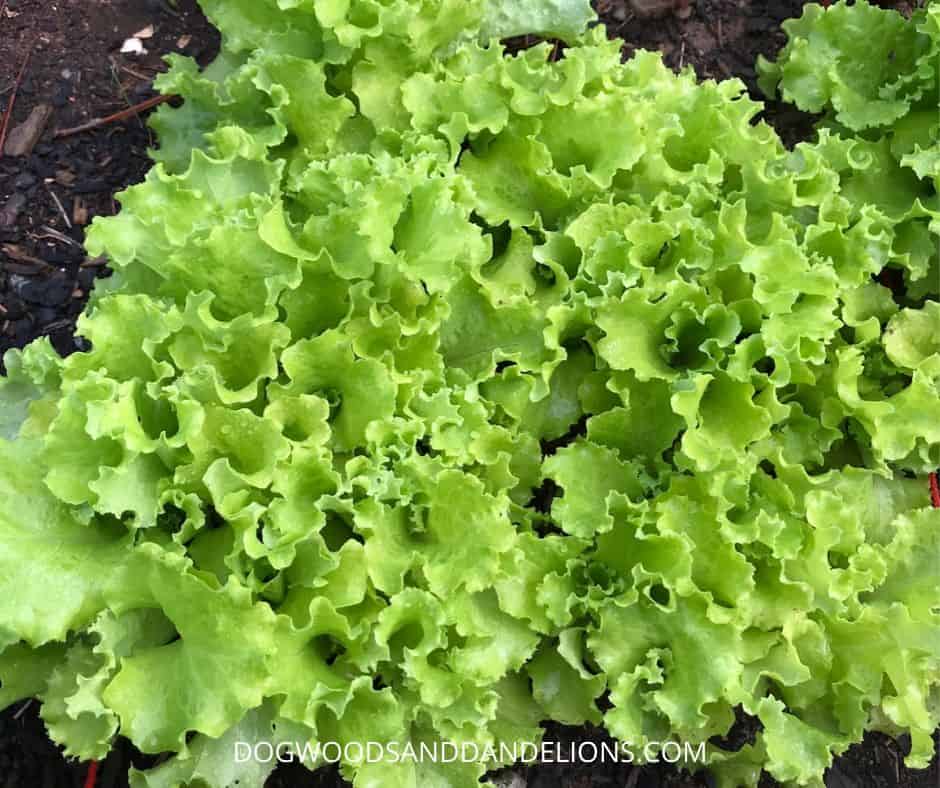
If you grow lettuce, grow leaf lettuce varieties. Head lettuce such as iceberg will only give you one harvest.
However, you can keep cutting the outer leaves of leaf lettuce and it will continue to produce until it gets too hot and goes to seed.
If you love fresh herbs, grow a small herb garden. The initial investment in a few herb plants is about what you pay for the fresh herbs at the store.
And they will provide you with fresh herbs all season. Plus, you can freeze or dehydrate the extras for use during the winter.
Grow Quick Maturing Vegetables
Another way to grow a garden on a budget is to grow fast-maturing vegetables. You will be able to eat from your garden sooner than if you grow crops that take longer to reach maturity.
Some quick maturing vegetables include lettuce, Swiss chard, spinach, radishes, and cucumbers. All of these can easily be started from seed directly in the garden too.
Read Fast Growing Vegetables to learn more quick-to-grow vegetables.
Succession Planting
This idea goes along with growing quick maturing vegetables. Once a vegetable has reached the end of its useful life, pull it out and replace it with something else.
Sometimes, this can seem harsh, but to get the most out of a small garden, remove plants that aren’t producing.
For instance, grow peas in early spring and replace them with beans in the summer. Once the lettuce has bolted at the end of the spring season, add a pepper plant or two to that same area.
This ensures you maximize your harvest from even a small garden.
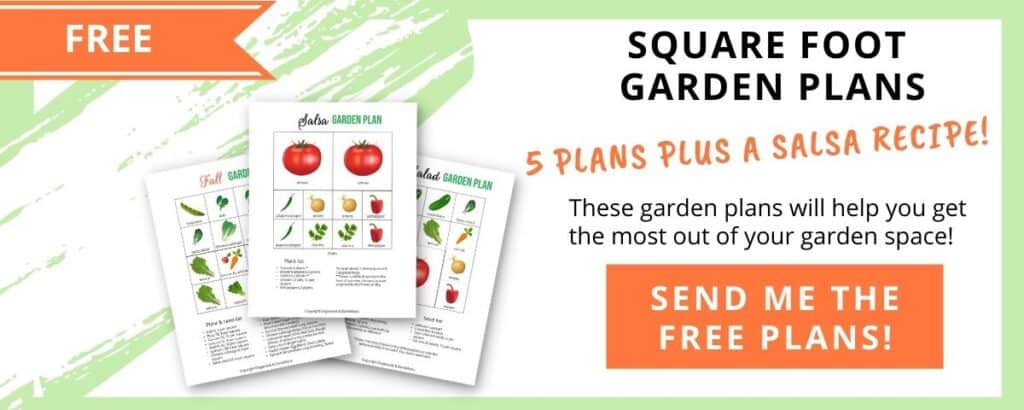
Start Your Own Seeds?
Many people tout starting your own seeds as a way to save money gardening. And yes, I’ll admit this definitely saves money in the long run.
HOWEVER, if this is the first year you are growing a garden, starting your own seeds for plants such as broccoli, cauliflower, peppers, and tomatoes, will NOT save you money.
Why? Because to properly start these seeds, you will need a grow light. And you could probably buy all your transplants for a couple of years for the cost of one grow light. (Remember, we are starting a SMALL garden! 😉)
If you have been gardening a few years, and know you plan to keep growing a garden, by all means, invest in a grow light. (This is my favorite.) But wait a couple of years until you are sure it is something you enjoy.
To Start Seeds Cheaply
So if you do decide to start seeds, I recommend using Jiffy pellets. They are my very favorite way to start seeds as they don’t typically make a huge mess. (Look for them at your local Walmart or home improvement store to get the best price.)
However, if you don’t have them or don’t want to purchase them, you can use paper cups you may have laying around the house. Be sure to punch holes in the bottom for drainage.
You can also make newspaper pots and fill them with potting soil. There are specialty tools that will help you do this, or you can use a glass or an old wine bottle.
As a last resort, you can start seeds in a tray filled with potting soil or seed starting mix. Lots of people seem to do this with success, but I always worry about disturbing the roots when transplanting them.
Know What to Direct-Seed and what to Purchase as Plants
When starting a garden on a budget, it is helpful to know what should be directly seeded in the garden and what you should buy transplants for. While these lists aren’t comprehensive, these are some of the most popular vegetables people grow.
Spend the Money on Transplants
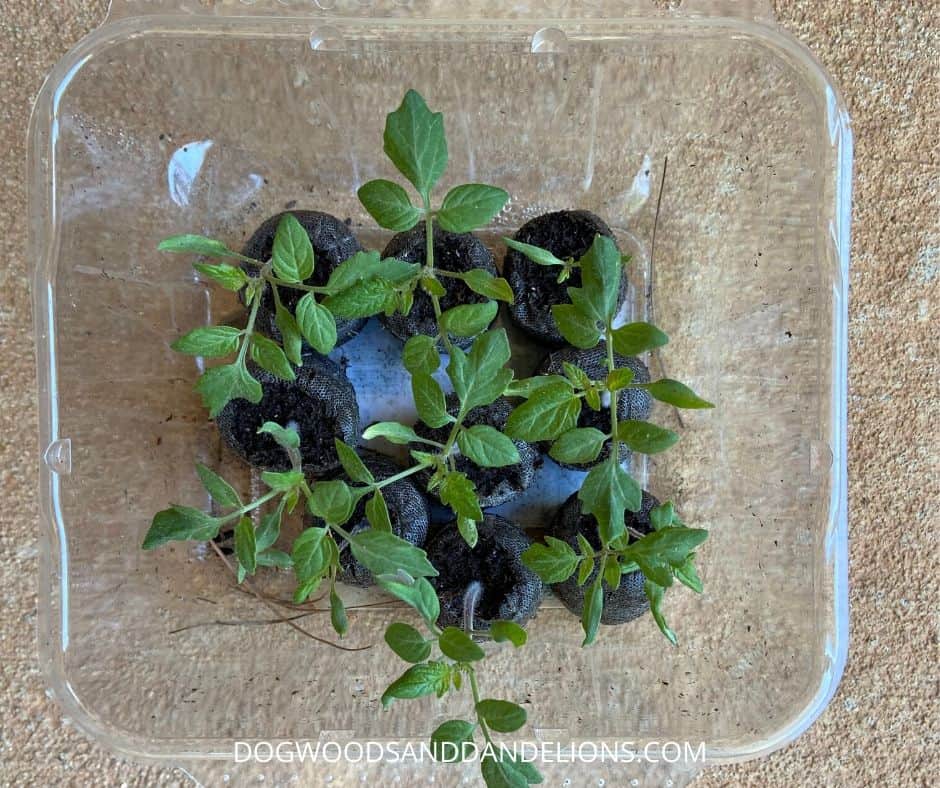
Many vegetables won’t germinate well or will take a long time to produce fruit if planted directly in the garden. When you look at a tomato seed packet, it will tell you the days until harvest.
However, that date is from when you put the PLANT in the ground outdoors, not from when you start the seed. So these are crops you should purchase as transplants unless you are starting your own indoors.
- broccoli
- Brussels sprouts
- cabbage
- cauliflower
- eggplant
- peppers
- tomatoes
Direct-Sow These Vegetables
These vegetables are easy to germinate from seed, so you can start these seeds directly in the garden to save money.
- beans
- beets
- carrots
- corn
- cucumbers
- kale
- lettuce
- melons
- okra
- peas
- radishes
- squash
- Swiss Chard
- turnips
- zucchini
Any of your root crops should definitely be started directly in the garden as they do not transplant well.
You will sometimes see lettuce, cucumbers, squash, and zucchini plants for sale at your local nursery. If your budget allows, you can purchase these, but I only found a 5-day difference in squash I started indoors, and seeds sown directly in the ground.
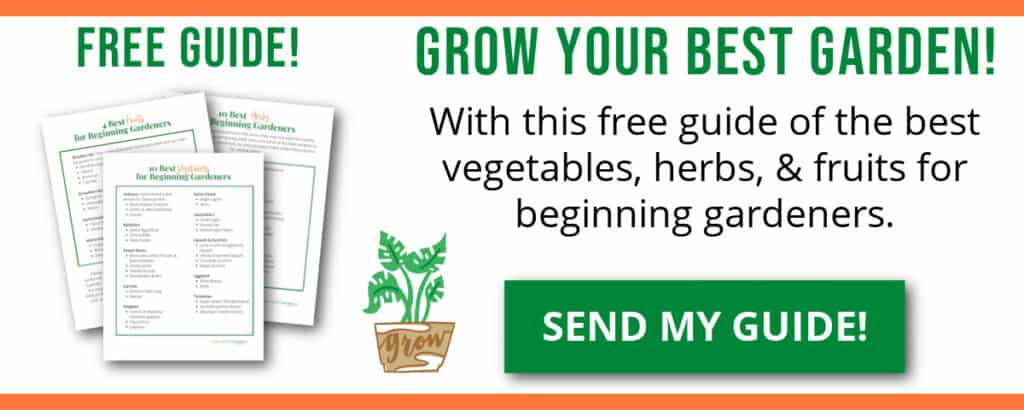
Don’t Let Your Harvest Go To Waste
Once it’s time to start picking your produce, be sure to pick it and use it. You aren’t saving any money if you throw the produce away!
While there are some vegetables you can’t preserve (Lettuce, I’m looking at you!) most can be frozen, canned, or dehydrated for later. Spend some time researching how to use and preserve your produce.
Usually freezing is the easiest method for beginning gardeners. As long as you have some extra space in your freezer, you can freeze tomatoes in almost no time at all.
Or turn those extra peppers into roasted red (and yellow and orange) peppers and then freeze them. They will be a welcome addition to a sandwich or soup in the dead of winter.
So Let’s Start A Garden On A Budget This Year
I hope this is the year you decide to start a garden. And when you do, I hope these suggestions help you keep your costs down if you are on a limited budget.
If you have any other ideas for gardening on a budget, I would love to hear your suggestions. Drop a comment below and tell me how you save money when growing a garden.
Related Posts
- How to start a container garden
- How to manage pests in your garden
- Ways to preserve your garden harvest
